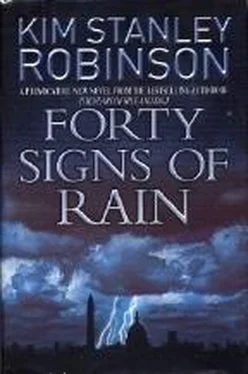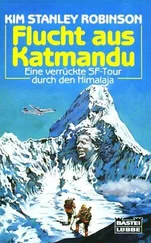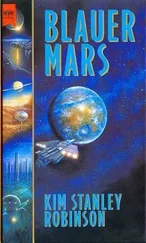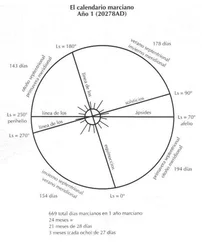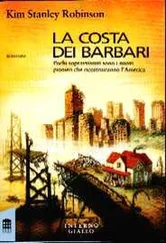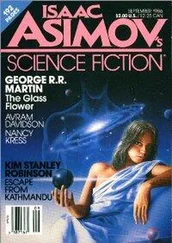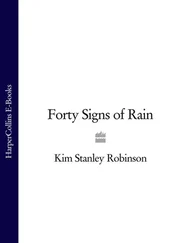Then Kenzo called up, raving about the storm and the flood, and Frank joined everyone else in the building in watching the TV news and the NOAA website, trying to get a sense of how serious things were. It became clear that things were serious indeed when one channel showed Rock Creek overflowing its banks and running deep down the streets toward Foggy Bottom; then the screen shifted the image to Foggy Bottom, waist-deep everywhere, and then came images from the inundated-to-the-rooftops Southwest district, including the classically pillared War College Building at the confluence of the Potomac and the Anacostia, sticking out of the water like a temple of Atlantis.
The Jefferson Memorial was much the same. Rain-lashed rooftop cameras all over the city transmitted more images of the flood, and Frank stared, fascinated; the city was a lake.
The climate guys on the ninth floor were already posting topographical map projections with the flood peaking at various heights. If the surge got to twenty feet above sea level at the confluence of the Potomac and the Anacostia, which Kenzo thought was a reasonable projection given the tidal bore and all, the new shore along this contour line would run roughly from the Capitol up Pennsylvania Avenue to where it crossed Rock Creek. That meant the Capitol on its hill, and the White House on its lower rise, would probably both be spared; but everything to the south and west of them was underwater already, as the videos confirmed.
Upstream monitoring stations showed that the peak of the flood had not yet arrived.
“Everything has combined!” Kenzo exclaimed over the phone. “It’s all coming together!” His usual curatorial tone had shifted to that of an impresario—the Master of Disaster—or even to an almost parental pride. He was as excited as Frank had ever heard him.
“Could this be from the Atlantic stall?” Frank asked.
“Oh no, very doubtful. This is separate I think, a collisionary storm. Although the stall might bring more storms like this. Windier and colder. This is what that will be like!”
“Jesus…Can you tell me what’s going on on the Virginia side?” There would be no way to cross the Potomac until the storm was over. “Are people working anywhere around here?”
“They’re sandbagging down at Arlington Cemetery,” Kenzo said. “There’s video on channel 44. It’s got a call out for volunteers.”
“Really!”
Frank was off. He took the stairs to the basement, to be sure he didn’t get caught in an elevator, and drove his car up onto the street. It was awash in places, but only to a depth of a few inches. Possibly this would soon get worse; runoff wouldn’t work when the river was flowing back up the drainpipes. But for now he was okay to get to the river.
As he turned right and stopped for the light, he saw the Starbucks people out on the sidewalk, passing out bags of food and cups of coffee to the cars in front of him. Frank opened his window as one of them approached, and the employee passed in a bag of pastries, then handed him a paper cup of coffee.
“Thanks!” Frank shouted. “You guys should take over emergency services!”
“We already did. You go and get yourself out of here.” She waved him on.
Frank drove east toward the river, laughing as he downed the pastry. Like everyone else still on the road, he plowed through the water at about five miles an hour. Fire trucks passed through at a faster clip, leaving big wakes.
As he crossed one intersection Frank spotted a trio of men ducking behind a building, carrying something. Could there be looters? Would anyone really do it? How sad to think that there were people so stuck in always defect mode that they couldn’t get out of it, even when a chance came for everything to change. What a waste of an opportunity!
Eventually he came to a roadblock and parked, following the directions of a man in an orange vest. It was a moment of hard rain. In the distance he could see people passing sandbags down a line, just to the east of the U.S. Marines’ Memorial. He hustled over to join them.
From where he worked he could often see the Potomac, pouring down the Boundary Channel between the mainland and Columbia Island, tearing away the bridges and the marinas and threatening the low-lying parts of Arlington National Cemetery. Hundreds or perhaps even thousands of people were working around him, carrying small sandbags that looked like fifty-pound cement bags, and no doubt were about that heavy. Some big guys were lifting them off truck beds and passing them to people who passed them down lines, or carried them over shoulders, to near or far sections of a sandbag wall under the Virginia end of Memorial Bridge, where firemen were directing construction.
The noise of the river and the rain together made it hard to hear. People shouted to one another, sharing instructions and news. The airport was drowned, old Alexandria flooded, the Anacostia Valley filled for miles. The Mall a lake, of course.
Frank nodded at anything said his way, not bothering to understand, and worked like a dervish. It was very satisfying. He felt deeply happy, and looking around he could see that everyone else was happy too. That’s what happens, he thought, watching people carry limp sandbags like coolies out of an old Chinese painting. It takes something like this to free people to be always generous.
Late in the day he stood on their sandbag wall. It gave him a good view over the flood. The wind had died down, but the rain was falling almost as hard as ever. In some moments it seemed there was more water in the air than air.
His team had been given a break by a sudden end to the supply of sandbags. His back was stiff, and he stretched himself in circles, like the trunks of the trees had been doing all day. The wind had shifted frequently, and had included short hard blasts from the west or north, vicious slaps like microbursting downdrafts. But now there was some kind of aerial truce.
Then the rain too relented. It became a very light drizzle. Over the foamy water in the Boundary Channel he could now see far across the Potomac proper: a swirling brown plate, sheeting as far as he could see to the east. The Washington Monument was a dim obelisk on a watery horizon. The Lincoln Memorial and Kennedy Center were both islands in the stream. Black clouds formed a low ceiling above them, and between the two, water and cloud, he could feel the air being smashed this way and that. Despite the disorderly gusts he was still warm from his exertions, wet but warm, with only his hands and ears slightly nipped by the wind. He stood there flexing his spine, feeling the tired muscles of his lower back.
A powerboat growled slowly up the Boundary Channel below them. Frank watched it pass, wondering how shallow its draft was; it was twenty-five or maybe even thirty feet long, a rescue boat like a sleek cabin cruiser, hull painted a shade of green that made it almost invisible. The illuminated cockpit shed its light on a person standing upright at the stern, looking like one of the weird sisters in the movie Don’t Look Now.
This person looked over at the sandbag levee, and Frank saw that it was the woman from the elevator in Bethesda. Shocked, he put his hands to his mouth and shouted, “HEY!” as loud as he could, emptying his lungs all at once.
No sign in the roar of flood and rain that she had heard him. Nor did she appear to see him waving. As the boat began to disappear around a bend in the channel, Frank spotted white lettering on its stern—GCX88A—then it was gone. Its wake had already splashed the side of the levee and roiled away.
Frank pulled his phone out of his windbreaker pocket, shoved it in his ear, then tapped the button for NSF’s climate office. Luckily it was Kenzo who picked up. “Kenzo, it’s Frank—listen, write down this sequence, it’s very important, please? GCX88A, have you got that? Read it back. GCX88A. Great. Great. Wow. Okay, listen Kenzo, that’s a boat’s number, it was on the stern of a powerboat about twenty-six feet long. I couldn’t tell if it was public or private, I suspect public, but I need to know whose it is. Can you find that out for me? I’m out in the rain and can’t see my phonepad well enough to Google it.”
Читать дальше
Конец ознакомительного отрывка
Купить книгу
